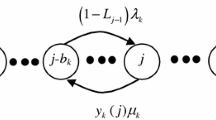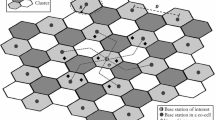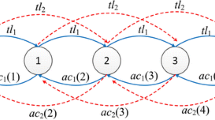Abstract
Code Division Multiple Access (CDMA) technology is gaining momentum as the preferred wireless system for the next generation Personal Communication Systems (PCS). In CDMA systems, voice is encoded and packaged in variable length packets that are transported between the mobile station and the switching center. Although the packetization provides a great flexibility in resource allocation, it poses a Quality of Service (QoS) problem on voice. In this paper, we discuss link dimensioning for a typical CDMA system. We consider a T1/E1 link between a CDMA Basestation Transceiver System (BTS) and the Base Station Controller (BSC). Traffic from various voice sources is subject to a framing scheme, which presents a semi-periodic batch input at the T1/E1 interface cards. We analyze the resulting queuing system using discrete-time analysis and large deviations theory and verify our results by simulation. We provide results for the minimum link capacity needed to support a given number of CDMA voice sources. Our results show the potential statistical gain that can be achieved by voice packetization for all practical values of link capacities.
Similar content being viewed by others
References
M.H. Ackroyd, Computing the waiting time distribution for the G/G/1 queue by signal processing methods, IEEE Transactions on Communications COM-28(1) (January 1980) 52-58.
ATM Forum, AF-VTOA-0113.000, ATM Trunking Using AAL2 for Narrowband Services (February 1999).
A. Elwalid, D. Heyman, T.V. Lakshman, D. Mitra and A. Weiss, Fundamental bounds and approximations for ATM multiplexers with applications to video teleconferencing, IEEE Journal on Selected Areas in Communications 13 (1995) 1004-1016.
A.I. Elwalid and D. Mitra, Effective bandwidth of general markovian traffic sources and admission control of high speed networks, IEEE Transactions on Networking 1 (1993) 329-343.
J.D. Gibson, ed., The Mobile Communications Handbook (IEEE Press/CRC Press, College Station, TX, 1996).
F. Hübner and P. Tran-Gia, Quasi-stationary analysis of a finite capacity asynchronous multiplexer with modulated deterministic input, in: Proc. ITC 13 (1991) pp. 723-729.
G. Kesidis, J. Walrand and C.-S. Chang, Effective bandwidths for multiclass Markov fluids and other ATM sources, IEEE Transactions on Networking 1 (1993) 424-428.
D.R. Manfield and P. Tran-Gia, Analysis of a finite storage system with batch input arising out of message packetization, IEEE Transactions on Communications COM-30(3) (1982) 456-463.
G. Ramamurthy and B. Sengupta, Delay analysis of a packet voice multiplexer by the ΣDi/D/1 queue, IEEE Transactions on Communications COM-39(7) (1991) 1107-1114.
Telecommunications Industry Association, TIA/EIA/IS-95, Mobile Station — Base Station Compatibility Standard for Dual Mode Wideband Spread Spectrum Cellular Systems (July 1993).
P. Tran-Gia, Discrete-time analysis for the interdeparture distribution of GI/G/1 queues, in: Teletraffic Analysis and Computer Performance Evaluation, eds. O.J. Boxma, J.W. Cohen and H.C. Tijms (North-Holland, Amsterdam, 1986) pp. 341-357.
P. Tran-Gia, Discrete-time analysis technique and application to usage parameter control modelling in ATM systems, in: Proc. 8th Australian Teletraffic Seminar, Melbourne, Australia (December 1993).
P. Tran-Gia and H. Ahmadi, Analysis of a discrete-time G[X]/D/1 — S queueing system with applications in packet-switching systems, in: Proc. INFOCOM '88 (1988) pp. 861-870.
S. Tsakiridou and I. Stavrakakis, Mean delay analysis of a statistical multiplexer with batch arrivals processes — a generalization to Viterbi's formula, Performance Evaluation 25 (1996) 1-15.
J. Van Ommeren, Simple approximations for the batch-arrival MX/G/1 queue, Operations Research 38(4) (1990) 678-685.
A.M. Viterbi, CDMA Principles of Spread Spectrum Communication (Addison-Wesley, Reading, MA, 1995).
A.M. Viterbi and A.J. Viterbi, Erlang capacity of a power controlled CDMA system, IEEE Journal on Selected Areas in Communications 11(6) (August 1993) 892-899.
A. Weiss, An introduction to large deviations for communication networks, IEEE Journal on Selected Areas in Communications 13(6) (1995) 938-952.
W. Whitt, Tail probabilities with statistical multiplexing and effective bandwidth for multi-class queues, Telecommunication Systems 2 (1993) 71-107.
Y. Zhao, Analysis of the GIX/M/c model, Queueing Systems 15 (1994) 347-364.
Author information
Authors and Affiliations
Rights and permissions
About this article
Cite this article
Elsayed, K.M., Gerlich, N. & Tran-Gia, P. Efficient Design of Voice Carrying Fixed-Network Links in CDMA Mobile Communication Systems. Telecommunication Systems 17, 9–29 (2001). https://doi.org/10.1023/A:1016643818413
Issue Date:
DOI: https://doi.org/10.1023/A:1016643818413




